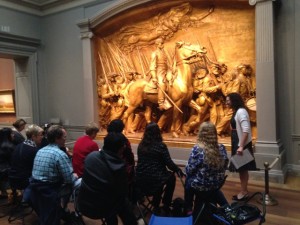Last month, it was my privilege to organize a course for Internal Medicine 2016, in collaboration with the American College of Physicians and the National Gallery, and with Harvard Medical School’s Joel Katz, MD, and Shahram Khoshbin, MD.
Together, we spent the better part of a day with almost eighty caregivers working to build skill and self-awareness in the four areas that make up what I call “aesthetic attention”: attunement, representation, flexible thinking, and group communication. After introductory didactics, we broke into the small groups and entered the galleries. Led by seasoned National Gallery educators, participants explored the topic in up-close encounters with works of art with the kind of depth and freedom that can uniquely happen in art museum spaces. Following a short refreshment stop, the program concluded with a clinical case example led by Drs. Katz and Khoshbin, in which participants applied the same aesthetic attention skills with rigor and specificity. Throughout the program, we emphasized connections to personal practice.
Liz Diament leading a “slow art” experience with the Shaw Memorial, National Gallery
Of the many pearls from the session, I wanted to share three that bubbled up just on the heels of a discussion of a work of art facilitated by Liz Diament, educator at the National Gallery (pictured right), who kindly allowed me to observe her group.
The piece we worked with was Augustus Saint-Gaudens’ Shaw Memorial, which you can view (zoom in!) and learn more about here.
- “I feel more curious about this work of art after looking at it for sixty minutes than I would if I were told about it.”
When one participant made this remark, it put a finger on one of the funny things about curiosity: stirring it up takes looking in the first place. It takes opening up the portals to the brain-machine (eyes, ears, fingertips), casting them out upon the material of the world (new, old, or somewhere in between), and turning the whole apparatus on. Intake takes conscious work—as much effort on the front of containing as it does attuning—but the reward is in the relationship.
This participant’s comment suggests to me that if she were to visit the National Gallery again, she wouldn’t feel as if she’s seen all there is to see about the Shaw Memorial; she might even be so inclined to stop by and see it again. That same quality of relationship came through in the case demonstration, when Drs. Katz and Khoshbin spoke about a patient they have shared for over ten years and the learning through that time.
And what’s more: what might this mean for handoffs? Or for teacher practice?
2. “You guys didn’t talk about the hats.”
A visitor seated on a bench behind our group contributed this comment about thirty-five minutes in. I had noticed him earlier, listening quietly, his attentive eyes a perfect example of silent engagement. He introduced himself as someone who had served in the military, and clued us in that there is something really special about hats in the army.
“Everyone gets the same hat,” he explained, “but nobody wears it in the same way. How you wear your hat is one of the only ways you can squeeze a little personal style into your uniform.”
This was an unexpected, real-time example of group communication. This young man, an outsider to our group, had the experience and perspective to help us see a fuller picture. His comment prompted revisiting of earlier themes about the soldiers and their individuality, and deepened our sense of the humanity of the soldiers even further.
This moment is also an interesting one as it comes up against the backdrop of some of the shifts in thinking about diagnosis in healthcare. Whose job is a diagnosis? Traditional paradigms consider it the doctor’s job, though patient safety literature indicates we would do better to update our view that diagnosis is achieved through co-production of meaning between clinicians (across disciplines and levels) as well as patients and family.
Jarek Tuszynski / CC-BY-SA-3.0 & GFDL (http://www.gnu.org/copyleft/fdl.html)], via Wikimedia Commons
- “I have been teaching from this work of art for fourteen years, and never knew about the hats. I’ll bring this new knowledge into future teaching.”
Liz really rose to it as a facilitator after the young man joined our discussion, modeling teaching-as-learning in real-time. And—“new knowledge”—did you catch that? We often think about the sources for knowledge as numerals or narrative, but it is just as importantly gleaned from observation.
Because I believe that the thriving viewpoints of caregivers are healthcare’s greatest resource, it was a joy to organize a workshop designed to spark curiosity and to keep views moving. Thanks to all who made it possible: the American College of Physicians, the National Gallery, Drs. Katz and Khoshbin, and especially to the care providers who are up against so much in order to give of their views, yet still they show up anyway.
Soldier on, friends.


![Jarek Tuszynski / CC-BY-SA-3.0 & GDFL [CC BY-SA 3.0 (http://creativecommons.org/licenses/by-sa/3.0) or GFDL (http://www.gnu.org/copyleft/fdl.html)], via Wikimedia Commons](http://www.artspractica.com/wp-ap/wp-content/uploads/2016/06/1024px-Robert_Gould_Shaw_Memorial_-_detail-640x545.jpg)
